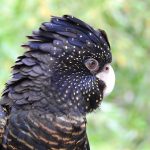RED-TAILED BLACK COCKATOO
The Red-tailed black cockatoo is a striking and iconic species of cockatoo native to Australia. It is a large cockatoo species, with males typically larger than females. It has predominantly black plumage, which gives it its name, and a distinctive red panel on the tail feathers. The plumage of the female has more yellow markings on the head and wings compared to the male.
There are four recognized subspecies of the red-tailed black cockatoo, which vary slightly in size and distribution across different regions of Australia. The subspecies are: C. banksii banksii (forest red-tailed black cockatoo), C. banksii macrorhynchus (Carnaby’s black cockatoo), C. banksii naso (Baudin’s black cockatoo), and C. banksii samueli (south-eastern red-tailed black cockatoo).
The Red-tailed black cockatoo is found in various parts of Australia, including the south-western, south-eastern, and north-eastern regions. Each subspecies has its specific range within these areas. For example, Carnaby’s black cockatoo (C. banksii macrorhynchus) is found in the south-west of Western Australia.
Red-tailed black cockatoos mainly feed on seeds, nuts, and fruits from various native plants, including eucalyptus and banksia species. They have powerful beaks designed for cracking open hard seed pods.
These cockatoos are often seen in small to large flocks, especially during feeding and roosting times. They are highly social birds and have a distinctive, loud call that can be heard over long distances. During breeding season, pairs will separate from the flock to nest and raise their chicks.
Some subspecies of the red-tailed black cockatoo, such as Carnaby’s black cockatoo (C. banksii macrorhynchus), are listed as endangered due to habitat loss and fragmentation, as well as threats from human activities and introduced predators.
The red-tailed black cockatoo is a magnificent and culturally significant bird in Australia. Its survival is dependent on ongoing conservation efforts and the protection of its native habitat.





















